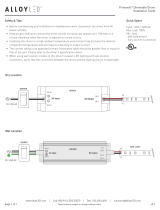
9
(See Diagram 4, p. 28, to locate the following switches, indicator lights and other features.)
11.. OOppeerraattiinngg MMooddee SSwwiittcchh::
This switch selects the APS operating mode (either
“AUTO/REMOTE”,“OFF” or “CHARGE ONLY”). See “Set Operating Mode Switch”, p. 8 to
select the appropriate setting for this switch.
22.. ““CCOONNFFIIGGUURRAATTIIOONN SSWWIITTCCHHEESS””——DDIIPP SSwwiittcchheess::
These four switches must be set for the
type of battery your APS will be connected to and the voltage points at which your APS
will switch to battery power. See “Configuration”, p. 5 to select the optimum settings for
these switches.
33.. ““LLIINNEE””::
This green light will turn continuously ON whenever connected equipment is
receiving utility-supplied AC power and your APS is set to “AUTO/REMOTE”,meaning that
it will automatically switch to battery power if AC power becomes unavailable. It will
flash intermittently when connected equipment is receiving utility power and your APS’s
Operating Mode Switch is set to “CHARGE ONLY” to indicate that the APS’s inverter is
OFF and that the APS will not supply power from its batteries.
44.. ““IINNVV””::
This yellow light will turn continuously ON whenever connected equipment is
receiving battery-supplied AC power.It will flash if the APS does not detect the minimum
load necessary to activate the inverter.
55.. ““LLOOAADD””::
When your UPS is receiving utility-supplied AC power, this red light will turn
continuously ON when the APS’s load is between 80% and 110% of capacity, to alert you
that the inverter might not be able to support the load.The light will flash intermittently
after the APS’s inverter shuts down due to a severe overload or overheating. If this hap-
pens, turn Operating Mode Switch OFF. Remove the overload and let the unit cool.You
may then turn the APS ON after it cools.
66.. ““BBAATTTTEERRYY HHII//MMEEDD//LLOO””::
These THREE lights will turn ON in several sequences to show
the approximate charge level and voltage of your connected battery bank and alert you
to several fault conditions:
BATTERY CHARGE INDICATION (Approximate)
IInnddiiccaattoorr CChhaarrggeerr FFuunnccttiioonn BBaatttteerryy LLeevveell
((LLIINNEE OONN)) ((IINNVV OONN))
Green Float High Charge State
Green & yellow Absorption (50% Done) High/Medium Charge State
Yellow Absorption Medium Charge State
Yellow & red Bulk (50% Done) Medium/Low Charge State
Red Bulk Low Charge State
All three lights off Charger Inhibited Very Low Charge State
Flashing green Equalizing Charge N/A
Flashing red N/A Low Battery Shutdown
All three lights flash slowly* Excessive discharge; check batteries
All three lights flash quickly** Overcharge;check charger
**
Approximately 1/2 second on, 1/2 second off. See Troubleshooting section.
** Approximately 1/4 second on, 1/4 second off. See Troubleshooting section.
Switches, Indicator Lights & Other Features
Switches
Indicator Lights
200205002 93-2058 APS612 Manual.qxd 9/17/2002 4:53 PM Page 9
















